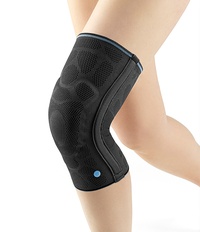Arthrosis
The damaged joint
Arthrosis is one of the most common joint diseases in Germany today. The main causes are misalignments and straining of important joints. But how does arthrosis develop? Our joints act as connectors between two immovable bones, and are surrounded by cartilaginous tissue that provides protection between the bones. Arthrosis occurs when the tissue shows signs of wear - a change in the joint and pain during movement are almost inevitable.
Causes and consequences of Arthrosis
For patients with arthrosis, the articular cartilage loses its strength, as does the bone tissue, all of which is located under the cartilage, which compresses at the heavily stressed areas. The cartilage is roughened and cracks develop in cartilage tissue. Consequently, the bone is exposed and damaged. In the advanced stage of the disease, the cartilage can completely disappear. The affected bone then rubs on bone and sometimes causes great pain. Arthrosis can be defined as cartilage damage in combination with bone alteration or damage.

Arthrosis can arise from a variety of causes. A congenital malformation or weakness of the joints can cause the cartilage to dissolve and the bone to change as a result. One cause of arthrosis can be the long-term consequences of an accident - during sports, at work or in traffic. However, the main cause of joint wear and tear is excessive long-term stress on the joints and incorrect movement.
Symptoms of Arthrosis
In the case of arthrosis, pain, swelling and restricted mobility of the surrounding muscles are possible. Not infrequently, inflammatory thrusts and thickening of the affected areas are associated with the course of the disease. In addition to hands and hips, the knees are particularly susceptible to arthrosis. Knee pain and swelling usually appear as concomitant symptoms. Strain or previous joint injuries can also be causes. In addition, axial misalignments or inflammations may be responsible for the cartilage wear. Often, the symptoms do not occur acutely, but develop gradually. Continuous pain during rest and under stress, reduced walking ability, and stiffness are common.
Treatment of Arthrosis
Arthrosis is usually treated symptomatically, with the aim of relieving pain and rebuilding the ability to move. Conservative treatment includes not only orthopedic aids such as orthoses but also physiotherapeutic exercises. Joint-gentle movements such as cycling and swimming can also help. The exercise strengthens the surrounding muscles, improves mobility and the articular cartilage is better nourished because fluid circulates. As a result, arthrosis progresses more slowly. In severe cases, there is the possibility of an operation in which artificial joints are implanted.
Arthrosis or Arthritis?
While arthrosis refers to cartilage wear in combination with bone alteration, arthritis refers to inflammation of the joint. This can happen when there is a bacterial infection. Also, a rheumatic disease, lyme disease, metabolic diseases or immunological reactions may cause arthritis. The treatment depends on the type of arthritis. Painkillers and anti-inflammatories are prescribed in most cases, but in some cases an operative procedure may be necessary.





